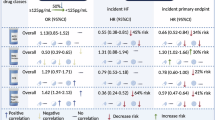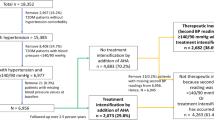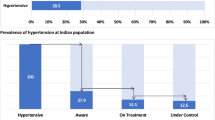Abstract
Antiplatelet therapy (AT) is indicated in hypertensive patients with increased cardiovascular risk. The literature about the adequate or inadequate prescription of AT is scarce. We conducted a prospective descriptive study to quantify therapeutic inertia and non-guideline-recommended prescription (NGRP) of AT (aspirinor clopidogrel or both), and to assess associated factors, calculating the adjusted odds ratios (ORs) from multivariate models. In 2007–2009, 712 primary health-care hypertensive patients in a Spanish region were enrolled. Inertia was defined as the lack of an AT prescription, despite being indicated by guidelines, whereas NGRP was defined as AT prescription when there was no guideline recommendation. We also recorded cardiovascular variables. Inertia and NGRP were quantified for primary and secondary prevention. Of 108 patients in secondary prevention, 53 had inertia (49.1%, 95% confidence interval (CI): 39.6–58.5%). Associated profile: female (OR=0.460, P=0.091), no dyslipidemia (OR=0.393, P=0.048), no coronary heart disease (OR=0.215, P=0.001) and high diastolic blood pressure (OR=1.076, P=0.016). In primary prevention, NGRP was present in 69 of 595 patients (11.6%, 95% CI: 9.0–14.2%). Associated profile: male (OR=1.610, P=0.089), smoking (OR=2.055, P=0.045), dyslipidemia (OR=3.227, P<0.001) and diabetes (OR=2.795, P<0.001). Although certain factors were clearly associated with these phenomena much still remains to be learnt.
This is a preview of subscription content, access via your institution
Access options
Subscribe to this journal
Receive 12 digital issues and online access to articles
$119.00 per year
only $9.92 per issue
Buy this article
- Purchase on SpringerLink
- Instant access to full article PDF
Prices may be subject to local taxes which are calculated during checkout

Similar content being viewed by others
References
Okonofua EC, Simpson KN, Jesri A, Rehman SU, Durkalski VL, Egan BM . Therapeutic inertia is an impediment to achieving the Healthy People 2010 blood pressure control goals. Hypertension 2006; 47 (3): 345–351.
Phillips LS, Branch WT, Cook CB, Doyle JP, El-Kebbi IM, Gallina DL et al. Clinical inertia. Ann Intern Med 2001; 135 (9): 825–834 Review.
Lobos JM, Royo-Bordonada MA, Brotons C, Alvarez-Sala L, Armario P, Maiques A et al. Guía europea de prevención cardiovascular en la prácticaclínica. Adaptación Española del CEIPC 2008. Rev Clin Esp 2009; 209 (6): 279–302.
Marquez Contreras E, Martín de Pablos JL, Gil Guillén V, Martel Claros N, Motero Carrasco J, Casado Martínez JJ . La inerciaclínicaprofesional y el incumplimientofarmacológico ¿Cómoinfluyen en el control de la HTA? Estudio CUMAMPA. Hipertensión 2008; 25 (5): 187–193.
Alonso Moreno FJ, Llisterri Caro JL, Rodríguez Roca GC, FerreiroMadueño M, González-Segura Alsina D, DivisónGarrote JA et al. Conducta del médico de atenciónprimaria ante el mal control de los pacienteshipertensos. Estudio PRESCAP 2006. Rev Clin Esp 2008; 208 (8): 393–399.
Belch J, MacCuish A, Campbell I, Cobbe S, Taylor R, Prescott R et al. The prevention of progression of arterial disease and diabetes (POPADAD) trial: factorial randomised placebo controlled trial of aspirin and antioxidants in patients with diabetes and asymptomatic peripheral arterial disease. BMJ 2008; 337: a1840.
Ogawa H, Nakayama M, Morimoto T, Uemura S, Kanauchi M, Doi N et al. Low-dose aspirin for primary prevention of atherosclerotic events in patients with type 2 diabetes: a randomized controlled trial. JAMA 2008; 300 (18): 2134–2141.
Antithrombotic Trialists' (ATT) Collaboration, Baigent C, Blackwell L, Collins R, Emberson J, Godwin J et al. Aspirin in the primary and secondary prevention of vascular disease: collaborative meta-analysis of individual participant data from randomized trials. Lancet 2009; 373 (9678): 1849–1860.
De Berardis G, Sacco M, Strippoli GF, Pellegrini F, Graziano G, Tognoni G et al. Aspirin for primary prevention of cardiovascular events in people with diabetes: meta-analysis of randomized controlled trials. BMJ 2009; 339: b4531.
Fowkes FG, Price JF, Stewart MC, Butcher I, Leng GC, Pell AC et al. Aspirin for Asymptomatic Atherosclerosis Trialists. Aspirin for prevention of cardiovascular events in general population screened for a low ankle brachial index: a randomized controlled trial. JAMA 2010; 303 (9): 841–848.
PedreraCarbonell V, Gil Guillén V, Orozco Beltrán D, PrietoErades I, Schwarz Chavarri G, MoyaGarcía I . Características de la demanda sanitaria en lasconsultas de medicina de familia de un área de salud de la ComunidadValenciana. AtenPrimaria 2005; 35 (2): 82–88.
Mancia G, De Backer G, Dominiczak A, Cifkova R, Fagard R, Germano G et al. 2007 Guidelines for the management of arterial hypertension: the task force for the management of arterial hypertension of the European Society of Hypertension (ESH) and of the European Society of Cardiology (ESC). J Hypertens 2007; 25 (6): 1105–1187.
World Medical Association Declaration of Helsinki. Recommendations guiding physicians in biomedical research involving human subjects. JAMA 1997; 277 (11): 925–926.
Viera AJ, Schmid D, Bostrom S, Yow A, Lawrence W, DuBard CA . Level of blood pressure above goal and clinical inertia in a Medicaid population. J Am Soc Hypertens 2010; 4 (5): 244–254.
Redón J, Coca A, Lázaro P, Aguilar MD, Cabañas M, Gil N et al. Factors associated with therapeutic inertia in hypertension: validation of a predictive model. J Hypertens 2010; 28 (8): 1770–1777.
Gil-Guillén V, Orozco-Beltrán D, Pérez RP, Alfonso JL, Redón J, Pertusa-Martínez S et al. Clinicalinertia in diagnosis and treatment of hypertension in primary care: quantification and associated factors. Blood Press 2010; 19 (1): 3–10.
Harris SB, Kapor J, Lank CN, Willan AR, Houston T . Clinical inertia in patients with T2DM requiring insulin in family practice. Can Fam Physician 2010; 56 (12): e418–e424.
US Preventive Services Task Force. Aspirin for the prevention of cardiovascular disease: U.S. Preventive Services Task Force Recommendation Statement. Ann Intern Med 2009; 150 (6): 396–404.
Berger JS, Roncaglioni MC, Avanzini F, Pangrazzi I, Tognoni G, Brown DL . Aspirin for the primary prevention of cardiovascular events in women and men: a sex-specific meta-analysis of randomized controlled trials. JAMA 2006; 295 (17): 306–313 2002.
Gkaliagkousi E, Passacquale G, Douma S, Zamboulis C, Ferro A . Platelet activation in essential hypertension: implications for antiplatelet treatment. Am J Hypertens 2010; 23 (3): 229–236.
Raju N, Sobieraj-Teague M, Hirsh J, O'Donnell M, Eikelboom J . Effect of aspirin on mortality in the primary prevention of cardiovascular disease. Am J Med 2011; 124 (7): 621–629.
Graham I, Atar D, Borch-Johnsen K, Boysen G, Burell G, Cifkova R et al. European guidelines oncardiovascular disease prevention in clinical practice: full text. Fourth JointTask Force of the European Society of Cardiology and other societies oncardiovascular disease prevention in clinical practice (constituted byrepresentatives of nine societies and by invited experts). Eur J Cardiovasc Prev Rehabil 2007; 14 (Suppl 2): S1–113.
Berger JS, Lala A, Krantz MJ, Baker GS, Hiatt WR . Aspirin for the prevention of cardiovascular events in patients without clinical cardiovascular disease: a meta-analysis of randomized trials. Am Heart J 2011 162 1 (115-24): e2.
Weil J, Colin-Jones D, Langman M, Lawson D, Logan R, Murphy M et al. Prophylactic aspirin and risk of peptic ulcer bleeding. BMJ 1995; 310 (6983): 827–830.
Yeomans ND, Lanas AI, Talley NJ, Thomson AB, Daneshjoo R, Eriksson B et al. Prevalence and incidence of gastroduodenal ulcers during treatment with vascular protective doses of aspirin. Aliment Pharmacol Ther 2005; 22 (9): 795–801.
Márquez-Contreras E, De Rivas-Otero B, Divisón JA, SobrevielaBlázquez E, Luque Otero M . Evaluamos y controlamosadecuadamente a los hipertensosatendidos en AtenciónPrimaria? Estudio HICAP. An Med Interna 2007; 24 (7): 312–316.
Marquez-Contreras E, Coca A, de la Figuera-vonWichmann E, Divisón JA, Llisterri JL, Sobrino J et al. Perfil de riesgo cardiovascular de los pacientes con hypertension arterial no controlada. Estudio Control-Project. Med Clin (Barc) 2007; 128 (3): 86–91.
Antithrombotic Trialist Collaboration. Collaborative meta-analysis of randomized trials of antiplatelet therapy for prevention of death, myocardial infarction and stroke in high risk patients. BMJ 2002; 324 (7330): 71–86.
Ong G, Davis TM, Davis WA . Aspirin is associated with reduced cardiovascular and all-cause mortality in type 2 diabetes in a primary prevention setting: the Fremantle Diabetes study. Diabetes Care 2010; 33 (2): 317–321.
Mancia G, Laurent S, Agabiti-Rosei E, Ambrosioni E, Burnier M, Caulfield MJ et al. Reappraisal of European guidelines on hypertension management: a European Society of Hypertension Task Force document. J Hypertens 2009; 27 (11): 2121–2158.
Coccheri S . Antiplatelet therapy: controversial aspects. Thromb Res 2012; 129 (3): 225–229.
Acknowledgements
We thank everyone who has contributed to the scientific content of the manuscript or provided technical support is in this section. We also thank the Conselleria de Sanitat (Valencian Community) for allowing us to use the equipment of the health centers and the computerized health system. We also thank Armina Sepehri for collaboration in the data computerization process, and Ian Johnstone for help with the English language version of the text. A research grant from the Department of Clinical Medicine at Miguel Hernández University was used to buy reagents for biochemical testing. This was the only role of the funding sources in the study.
Author information
Authors and Affiliations
Corresponding author
Ethics declarations
Competing interests
The authors declare no conflict of interest.
Rights and permissions
About this article
Cite this article
Martínez-Orozco, M., Perseguer-Torregrosa, Z., Gil-Guillén, V. et al. Suitability of antiplatelet therapy in hypertensive patients. J Hum Hypertens 29, 40–45 (2015). https://doi.org/10.1038/jhh.2014.25
Received:
Revised:
Accepted:
Published:
Issue date:
DOI: https://doi.org/10.1038/jhh.2014.25



